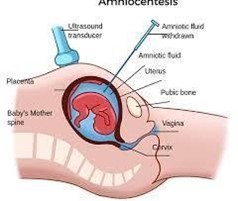A nurse in a prenatal clinic is instructing a client about an amniocentesis, which is scheduled at 15 weeks of gestation. Which of the following should be included in the teaching?

"The test will be performed if your baby's heart beat is heard."
"This test will determine if your baby's lungs are mature."
"After the test, you will be given Rh, immune globulin since you are Rh positive."
"This test requires the presence of an adequate volume of amniotic fluid."
The Correct Answer is D
A. "The test will be performed if your baby's heartbeat is heard."
Incorrect: Amniocentesis is not typically performed based on whether the baby's heartbeat is heard. It is done for specific diagnostic purposes, such as genetic testing or assessing certain fetal conditions.
B. "This test will determine if your baby's lungs are mature."
Incorrect: Amniocentesis does not determine fetal lung maturity. The test involves the extraction of a small amount of amniotic fluid to analyze fetal chromosomes and identify genetic conditions.
C. "After the test, you will be given Rh immune globulin since you are Rh positive."
Incorrect: Rh immune globulin (Rhogam) is given to Rhnegative pregnant women to prevent Rh sensitization, which occurs when an Rhnegative mother is exposed to
Rhpositive fetal blood. Rhogam is not directly related to amniocentesis.
D. "This test requires the presence of an adequate volume of amniotic fluid."
Correct: Amniocentesis requires a sufficient amount of amniotic fluid around the fetus for safe and accurate testing. If there is not enough amniotic fluid, the procedure may be postponed or canceled.
Nursing Test Bank
Naxlex Comprehensive Predictor Exams
Related Questions
Correct Answer is A
Explanation
A: Quickening, which refers to the sensation of the baby moving in the womb, is considered a presumptive sign of pregnancy. It is called "presumptive" because it is subjective and can be attributed to other causes, such as gas or gastrointestinal movements.
B: Positive signs of pregnancy are those that are attributed only to the presence of a fetus, such as fetal heartbeat or visualization on ultrasound. Feeling the baby move (quickening) is not specific enough to confirm pregnancy on its own.
C: Probable signs of pregnancy are more objective and can be detected by a healthcare provider, such as a positive pregnancy test or ballottement (rebounding of the fetus against the examiner's fingers). Feeling the baby move is not a probable sign as it is subjective and can be attributed to other factors.
D: "Potential sign of pregnancy" is not a recognized classification in pregnancy signs.
Correct Answer is D
Explanation
Choice A: Fetal lung maturity is not assessed through maternal serum alphafetoprotein testing. It is usually evaluated through tests such as amniocentesis or specialized ultrasound examinations closer to the third trimester.
Choice B: The maternal serum alphafetoprotein test specifically screens for certain birth defects and genetic conditions in the fetus, rather than general signs of physical and physiological
wellbeing.
Choice C: The maternal serum alphafetoprotein test is not used to identify Rh incompatibility. Rh incompatibility is determined through blood tests that assess the Rh factor of the mother's blood and the Rh status of the baby.
Choice D: The maternal serum alphafetoprotein test is a blood screening test that can identify neural tube defects (such as spina bifida) and chromosomal abnormalities (such as Down syndrome) in the fetus. The test measures the levels of alphafetoprotein in the mother's blood, and abnormal levels may indicate the need for further diagnostic testing.
Whether you are a student looking to ace your exams or a practicing nurse seeking to enhance your expertise , our nursing education contents will empower you with the confidence and competence to make a difference in the lives of patients and become a respected leader in the healthcare field.
Visit Naxlex, invest in your future and unlock endless possibilities with our unparalleled nursing education contents today
Report Wrong Answer on the Current Question
Do you disagree with the answer? If yes, what is your expected answer? Explain.
Kindly be descriptive with the issue you are facing.
